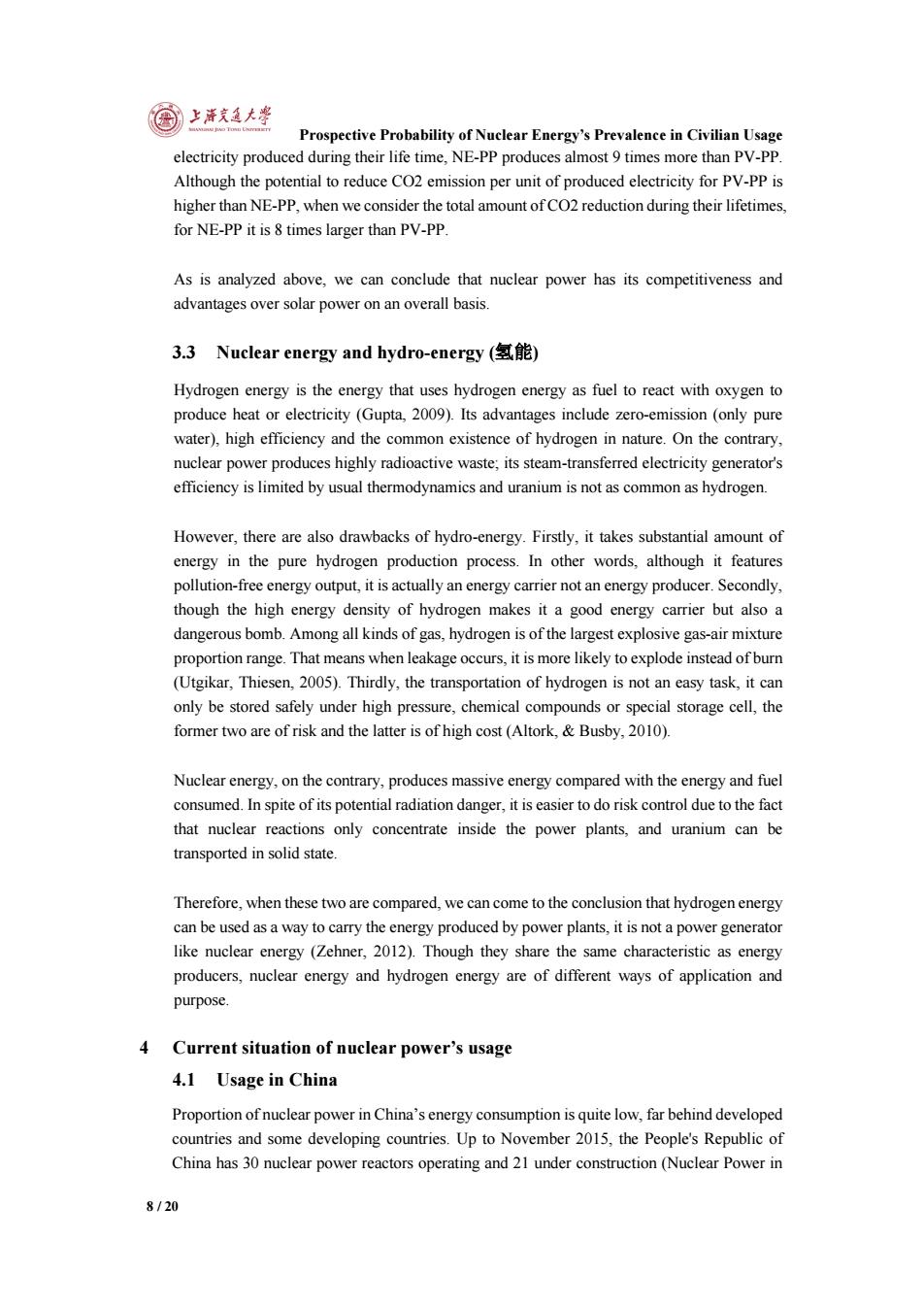正在加载图片...

©上洋克道大率 Prospective Probability of Nuclear Energy's Prevalence in Civilian Usage electricity produced during their life time,NE-PP produces almost 9 times more than PV-PP Although the potential to reduce CO2 emission per unit of produced electricity for PV-PP is higher than NE-PP,when we consider the total amount of CO2 reduction during their lifetimes, for NE-PP it is 8 times larger than PV-PP. As is analyzed above,we can conclude that nuclear power has its competitiveness and advantages over solar power on an overall basis. 3.3 Nuclear energy and hydro-energy(氢能) Hydrogen energy is the energy that uses hydrogen energy as fuel to react with oxygen to produce heat or electricity (Gupta,2009).Its advantages include zero-emission (only pure water),high efficiency and the common existence of hydrogen in nature.On the contrary, nuclear power produces highly radioactive waste;its steam-transferred electricity generator's efficiency is limited by usual thermodynamics and uranium is not as common as hydrogen. However,there are also drawbacks of hydro-energy.Firstly,it takes substantial amount of energy in the pure hydrogen production process.In other words,although it features pollution-free energy output,it is actually an energy carrier not an energy producer.Secondly, though the high energy density of hydrogen makes it a good energy carrier but also a dangerous bomb.Among all kinds of gas,hydrogen is of the largest explosive gas-air mixture proportion range.That means when leakage occurs,it is more likely to explode instead of burn (Utgikar,Thiesen,2005).Thirdly,the transportation of hydrogen is not an easy task,it can only be stored safely under high pressure,chemical compounds or special storage cell,the former two are of risk and the latter is of high cost(Altork,Busby,2010). Nuclear energy,on the contrary,produces massive energy compared with the energy and fuel consumed.In spite of its potential radiation danger,it is easier to do risk control due to the fact that nuclear reactions only concentrate inside the power plants,and uranium can be transported in solid state. Therefore,when these two are compared,we can come to the conclusion that hydrogen energy can be used as a way to carry the energy produced by power plants,it is not a power generator like nuclear energy (Zehner,2012).Though they share the same characteristic as energy producers,nuclear energy and hydrogen energy are of different ways of application and purpose. 4 Current situation of nuclear power's usage 4.1 Usage in China Proportion of nuclear power in China's energy consumption is quite low,far behind developed countries and some developing countries.Up to November 2015,the People's Republic of China has 30 nuclear power reactors operating and 21 under construction(Nuclear Power in 8/20Prospective Probability of Nuclear Energy’s Prevalence in Civilian Usage 8 / 20 electricity produced during their life time, NE-PP produces almost 9 times more than PV-PP. Although the potential to reduce CO2 emission per unit of produced electricity for PV-PP is higher than NE-PP, when we consider the total amount of CO2 reduction during their lifetimes, for NE-PP it is 8 times larger than PV-PP. As is analyzed above, we can conclude that nuclear power has its competitiveness and advantages over solar power on an overall basis. 3.3 Nuclear energy and hydro-energy (氢能) Hydrogen energy is the energy that uses hydrogen energy as fuel to react with oxygen to produce heat or electricity (Gupta, 2009). Its advantages include zero-emission (only pure water), high efficiency and the common existence of hydrogen in nature. On the contrary, nuclear power produces highly radioactive waste; its steam-transferred electricity generator's efficiency is limited by usual thermodynamics and uranium is not as common as hydrogen. However, there are also drawbacks of hydro-energy. Firstly, it takes substantial amount of energy in the pure hydrogen production process. In other words, although it features pollution-free energy output, it is actually an energy carrier not an energy producer. Secondly, though the high energy density of hydrogen makes it a good energy carrier but also a dangerous bomb. Among all kinds of gas, hydrogen is of the largest explosive gas-air mixture proportion range. That means when leakage occurs, it is more likely to explode instead of burn (Utgikar, Thiesen, 2005). Thirdly, the transportation of hydrogen is not an easy task, it can only be stored safely under high pressure, chemical compounds or special storage cell, the former two are of risk and the latter is of high cost (Altork, & Busby, 2010). Nuclear energy, on the contrary, produces massive energy compared with the energy and fuel consumed. In spite of its potential radiation danger, it is easier to do risk control due to the fact that nuclear reactions only concentrate inside the power plants, and uranium can be transported in solid state. Therefore, when these two are compared, we can come to the conclusion that hydrogen energy can be used as a way to carry the energy produced by power plants, it is not a power generator like nuclear energy (Zehner, 2012). Though they share the same characteristic as energy producers, nuclear energy and hydrogen energy are of different ways of application and purpose. 4 Current situation of nuclear power’s usage 4.1 Usage in China Proportion of nuclear power in China’s energy consumption is quite low, far behind developed countries and some developing countries. Up to November 2015, the People's Republic of China has 30 nuclear power reactors operating and 21 under construction (Nuclear Power in